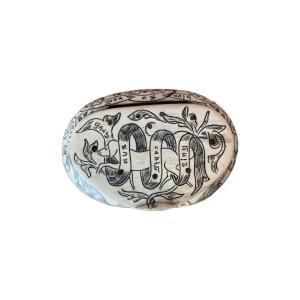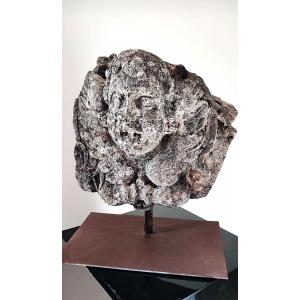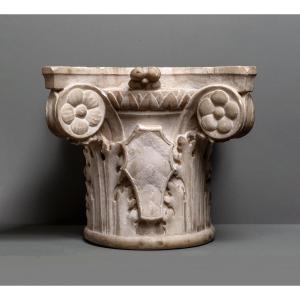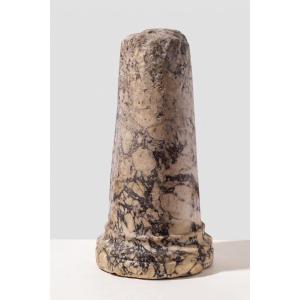Massif Central, Auvergne
Private Collection, Puy-de-Dôme
This superb limestone sculpture of Saint Sebastian is a striking example of 16th-century Auvergne folk art. Originating from a local workshop, it embodies the region’s religious fervor, where such works were often created for rural churches or local chapels.
The Sculpted Representation: A Work of Popular Piety
This limestone statue of Saint Sebastian adheres to the stylistic canons of folk art in the Massif Central. The simplicity of the forms and the expressive strength take precedence over complex anatomical details, reflecting a humble, direct approach suited to the sensitivity of rural communities. It aims to move the viewer emotionally rather than impress through technical precision.
The face of Saint Sebastian is gentle, almost childlike, reflecting the artisan’s intent to represent the saint’s purity rather than his physical suffering. The expression, slightly impassive, suggests resignation to fate—a recurrent theme in popular religious art. This modest treatment of the face contrasts with the implied violence of the arrows, creating a striking emotional tension. The artisan’s goal was not to shock but to encourage identification with the martyred saint, a model of patience and unwavering faith.
The visible holes on the torso were intended to hold wooden arrows—a less permanent material than stone—creating a contrast between the fragility of the arrows and the solidity of the sculpture. This choice of materials enhanced the realism of the work: the wood symbolized human frailty, while the stone represented the permanence of sacrifice and faith.
The tree to which he is bound is adorned with foliage motifs, carved with a naïve touch, highlighting the connection to nature, a constant in the lives of the region’s inhabitants. The stylized foliage offers a discreet yet symbolic background, suggesting the fertility of the land and the bond between nature and the divine.
The body of Saint Sebastian, nude except for a sculpted loincloth, also adheres to popular aesthetic canons. The minimal drapery is enlivened by delicately worked folds, influenced by the Renaissance but remaining true to the simplicity of folk art. The lightness of the loincloth balances the solidity of the figure, creating a harmonious visual equilibrium.
A Symbolic and Functional Approach
Intended as a devotional support in a small church or local chapel, this sculpture served as a reminder of Saint Sebastian’s sacrifice and his role as a protector against epidemics, especially the plague. The work, with its disarming simplicity, draws spiritual strength from its details, each element serving a symbolic function.
The statue, once polychrome, retains traces of paint, notably a deep red at the back, likely used to represent the martyr’s blood. The contrast between this color and the whiteness of the stone would have amplified the work’s visual and emotional impact, making the scene more tangible for the faithful. The natural wear of the polychrome adds a patina that testifies to the piece’s age and devotional use.
The Story of Saint Sebastian
Saint Sebastian is one of the most famous Roman martyrs. An officer in the army of Emperor Diocletian, he was denounced for his Christian faith. Refusing to sacrifice to the emperor despite the threat of rebellion, he was bound naked to a tree and used as a target by his own soldiers. Although he miraculously survived this ordeal with the help of Saint Irene, he was later captured again and beaten to death.
His cult dates back to the 4th century, mentioned by Saint Ambrose in his commentary on Psalm 118. Saint Ambrose, in his commentary on Psalm 118 (or Psalm 119 according to some traditions), uses the example of Saint Sebastian to illustrate fidelity and perseverance in faith, even in the face of severe trials. Although the exact details of these commentaries are not always specified in popular sources, Saint Ambrose saw in Sebastian a model of Christian courage, a soldier who upheld his faith despite persecution and the threat of death.
Psalm 118 itself exalts God’s law and fidelity to His commandments. By linking Saint Sebastian to this psalm, Ambrose reinforces the idea that his martyrdom exemplifies unwavering adherence to God’s word. Pope Damasus even built a church above his tomb, now one of the seven principal basilicas of Rome. However, the details of his martyrdom, as we know them, were documented later, in the 5th century.
Condition:
The statue shows signs of natural wear, notably on the limbs and the polychrome surface. One arm is missing, and there are chips visible near the feet (see photos).
Books and Iconography Consulted:
• Peter Brown, The Cult of the Saints: Its Rise and Function in Latin Christianity
• Émile Mâle, Religious Art After the Council of Trent
• Jacqueline Liéveaux-Boccador and Édouard Bresset, Medieval Statues in Private Collections, 2 volumes
Dimensions:
Height: 43.5 cm
All deliveries are made exclusively via DHL Express!


















































 Le Magazine de PROANTIC
Le Magazine de PROANTIC TRÉSORS Magazine
TRÉSORS Magazine Rivista Artiquariato
Rivista Artiquariato